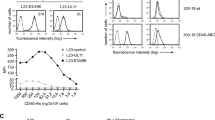Abstract
Many retroviral vectors for hematopoietic cell and other clinical gene therapy are derived from murine packaging cell lines. The exposure of these retroviruses and packaging cell lines to adult human serum (AS) inactivates them by complement and anti-α-galactosyl natural antibody-mediated mechanisms. We show that virus stability and infection efficiency of CRIP/BAG, a murine packaging cell line derived amphotropic retrovirus vector is reduced >95% following a 30-min incubation in AS. This inactivation is prevented by replacing AS with umbilical cord serum (CS), wherein full retroviral transduction efficiency is maintained after 30 min of incubation. The loss of retro- virus transduction efficiency in AS was smaller upon blockage of anti-α-galactosyl antibodies with galactose α1-3-galactose. Serum levels of CH 100, as well as C1q complement which inactivates retroviruses by an antibody-independent mechanism were similar in AS and CS. The high stability of CRIP/BAG retrovirus vector in CS is likely due to its lower levels of maternally derived anti-α-galactosyl antibodies. These results have implications for in vivo gene transfer in adults and also in newborns since neonates do not produce natural antibodies during the initial months of life.
This is a preview of subscription content, access via your institution
Access options
Subscribe to this journal
Receive 12 print issues and online access
$259.00 per year
only $21.58 per issue
Buy this article
- Purchase on Springer Link
- Instant access to full article PDF
Prices may be subject to local taxes which are calculated during checkout

Similar content being viewed by others
References
Miller AD . Human gene therapy comes of age Nature 1992 375: 455–460
Oldfield EH et al. Gene therapy for the treatment of brain tumors using intra-tumoral transduction with the thymidine kinase gene and intravenous gancyclovir Hum Gene Ther 1993 4: 39–69
Rollins SA et al. Retroviral vector producer cell killing in human serum is mediated by natural antibody and complement: strategies for evading the humoral immune response Hum Gene Ther 1996 7: 619–626
Takeuchi Y et al. Type C retrovirus inactivation by human complement is determined by both the viral genome and producer cell J Virol 1994 68: 8001–8007
Cosset F-L et al. High-titer packaging cells producing recombinant retroviruses resistant to human serum J Virol 1995 69: 7430–7436
Rother RP et al. A novel mechanism of retrovirus inactivation in human serum mediated by anti-α-galactosyl natural antibody J Exp Med 1995 182: 1345–1355
Andreadis S, Palsson BO . Coupled effects of polybrene and calf serum on the efficiency of retroviral transduction and the stability of retroviral vectors Hum Gene Ther 1997 8: 285–291
Agrawal YP et al. Cell-cycle kinetics and VSV-G pseudotyped retrovirus-mediated gene transfer in blood derived CD34+ cells Exp Hematol 1996 24: 738–747
Sinclair AM et al. Interaction of vesicular stomatitis virus-G pseudotyped retrovirus with CD34+ and CD34+CD38− hematopoietic progenitor cells Gene Therapy 1997 4: 918–927
Hayashi S et al. Establishment of complement-resistant retroviral vector by homologous restriction factor 20 gene Gene Therapy 1997 5: 282–285
Rigg RJ et al. A novel human amphotropic packaging cell line: high titer, complement resistance and improved safety Virology 1996 218: 290–295
Pensiero MN, Wysocki CA, Nader K, Kikuchi GE . Development of amphotropic murine retrovirus vectors resistant to inactivation by human serum Hum Gene Ther 1996 7: 1095–1101
Takeuchi Y et al. Sensitization of rhabdo-, lenti-, and spumaviruses to human serum by galactosyl(α1-3)galactosylation J Virol 1997 71: 6174–6178
Rother RP, Squinto SP, Mason JM, Rollins SA . Protection of retroviral particles in human blood through complement inhibition Hum Gene Ther 1995 6: 429–435
Sekhar M, Yu JM, Soma T, Dunbar CE . Murine long-term repopulating ability is compromised by ex vivo culture in serum-free medium despite preservation of committed progenitors J Hematother 1997 6: 543–549
Cooper NR, Jensen FC, Raymond MW, Oldstone MBA . Lysis of RNA tumor viruses by human serum: direct antibody-independent triggering of the classical complement pathway J Exp Med 1976 144: 970–984
Bartholomew RM, Esser AF . Mechanism of antibody-independent activation of the first component of complement (C1) on retrovirus membranes Biochemistry 1980 19: 2847–2853
Bartholomew RM, Esser AF, Muller-Eberhard HJ . Lysis of oncornaviruses by human serum: isolation of the viral complement (C1) receptor and identification as p15E J Exp Med 1978 147: 844–853
Russell DW, Berger MS, Miller AD . The effects of human serum and cerebrospinal fluid on retroviral vectors and packaging cell lines Hum Gene Ther 1995 6: 635–649
Shimizu K et al. Infectious retrovirus is inactivated by serum but not by cerebrospinal fluid or fluid from tumor bed in patients with malignant glioma Jpn J Cancer Res 1995 86: 1010–1013
Kohn DB, Parkman R . Gene therapy for newborns FASEB J 1997 11: 635–639
Author information
Authors and Affiliations
Rights and permissions
About this article
Cite this article
Agrawal, R., Karhu, K., Laukkanen, J. et al. Complement and anti-α-galactosyl natural antibody-mediated inactivation of murine retrovirus occurs in adult serum but not in umbilical cord serum. Gene Ther 6, 146–148 (1999). https://doi.org/10.1038/sj.gt.3300794
Received:
Accepted:
Published:
Issue Date:
DOI: https://doi.org/10.1038/sj.gt.3300794



